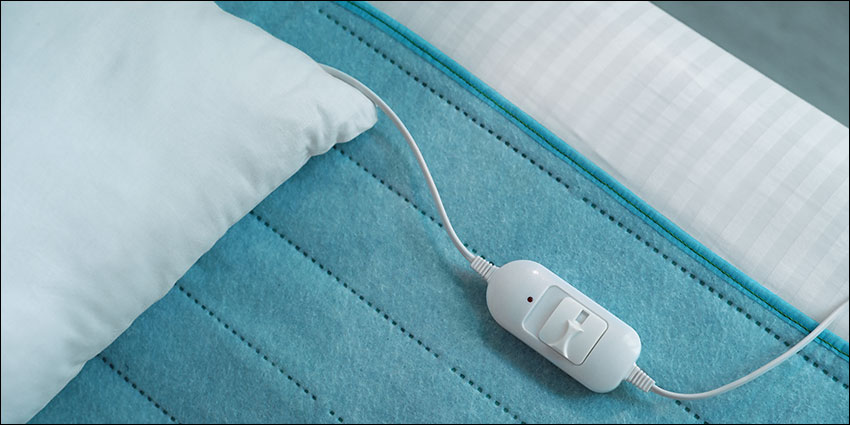If you’ve ever snuggled up under an electric blanket, you know how cozy and comforting they can be. But have you ever wondered if they could be causing those pesky headaches that seem to pop up out of nowhere? Well, I’m here to shed some light on the matter. So, can electric blankets cause headaches? Let’s dive in and find out.
Picture this: it’s a chilly winter night, and you can’t wait to crawl into bed and warm up under your trusty electric blanket. But the next morning, you wake up with a throbbing headache. Coincidence? Maybe not. While electric blankets are designed to provide warmth and comfort, there are a few potential factors that could contribute to those unwelcome head-pounders. So, in this article, we’ll explore the possible connections between electric blankets and headaches, and uncover some tips to help you enjoy your cozy nights without any unwanted side effects. Let’s get started!

Can Electric Blankets Cause Headaches?
Electric blankets are a popular choice for keeping warm during the colder months. They provide a cozy and comfortable experience, but have you ever wondered if they can cause headaches? In this article, we will explore the potential connection between electric blankets and headaches, as well as provide helpful information to alleviate any concerns you may have.
The Link Between Electric Blankets and Headaches
Headaches can be caused by a variety of factors, including stress, dehydration, and changes in weather. While there is no direct evidence to suggest that electric blankets can directly cause headaches, there are a few aspects to consider.
One possible factor is the electromagnetic fields (EMFs) emitted by electric blankets. EMFs are low-frequency radiation that can be produced by various electronic devices. Some individuals may be more sensitive to EMFs, which can potentially trigger headaches or other symptoms. However, it’s important to note that the level of EMF exposure from electric blankets is generally considered to be low and within safe limits.
EMF Exposure and Headaches
Research on the effects of EMF exposure on headaches is limited and inconclusive. Some studies suggest a potential link between high levels of EMF exposure and an increased risk of headaches, while others do not find a significant association. It’s worth noting that most studies focus on long-term exposure to high levels of EMFs, such as those found in occupational settings, rather than the low levels emitted by electric blankets.
If you are concerned about EMF exposure from your electric blanket, there are a few steps you can take to minimize your exposure. First, make sure to follow the manufacturer’s instructions and safety guidelines when using the blanket. Avoid folding or creasing the blanket, as this can increase EMF emissions. Additionally, consider keeping a safe distance between yourself and the blanket while it is in use.
Other Factors to Consider
While EMF exposure is one aspect to consider, there are other factors that may contribute to headaches when using electric blankets. For example, temperature regulation can play a role. Some individuals may experience headaches if the blanket is too hot or if there are significant temperature fluctuations throughout the night. It’s important to find a comfortable temperature setting that suits your individual needs.
Another factor to consider is the quality of the electric blanket itself. Older or poorly maintained blankets may emit more EMFs or have uneven heating, which could potentially contribute to discomfort or headaches. If you experience frequent headaches when using an electric blanket, it may be worth considering an upgrade to a newer model or consulting with a healthcare professional for further guidance.
In conclusion, while there is no direct evidence to suggest that electric blankets can cause headaches, some individuals may be more sensitive to the electromagnetic fields (EMFs) emitted by these devices. The level of EMF exposure from electric blankets is generally considered to be low and within safe limits. If you have concerns about EMF exposure, follow the manufacturer’s guidelines and consider other factors such as temperature regulation and the quality of the blanket. If headaches persist or worsen, it is always recommended to consult with a healthcare professional for further evaluation and guidance.
Key Takeaways: Can Electric Blankets Cause Headaches?
- Electric blankets may cause headaches in some individuals.
- The electromagnetic fields generated by electric blankets can disrupt sleep patterns.
- Heat from electric blankets can cause dehydration, leading to headaches.
- Prolonged use of electric blankets at high temperatures can lead to overheating, triggering headaches.
- It is important to follow safety guidelines and use electric blankets in moderation to minimize the risk of headaches.
Frequently Asked Questions
Do electric blankets cause headaches?
Electric blankets are designed to provide warmth and comfort during colder nights. While they are generally safe to use, some individuals may experience headaches as a result of using an electric blanket. However, it is important to note that the occurrence of headaches can vary from person to person, and not everyone will experience this side effect.
The primary reason why electric blankets may cause headaches is due to the electromagnetic fields (EMFs) they emit. Prolonged exposure to high levels of EMFs can potentially disrupt the normal functioning of the body and lead to various symptoms, including headaches. Additionally, some people may be more sensitive to EMFs than others, making them more prone to experiencing headaches when using electric blankets.
What are the other potential side effects of using electric blankets?
Aside from headaches, there are other potential side effects associated with the use of electric blankets. These include overheating, skin irritation, and increased risk of burns. Electric blankets generate heat through electric currents, and if used improperly or for extended periods, they can cause the body to overheat. This can lead to discomfort, dehydration, and in severe cases, heat stroke.
Furthermore, the heat generated by electric blankets can cause skin irritation or rashes, particularly for individuals with sensitive skin. It is important to follow the manufacturer’s instructions and use the blanket in moderation to minimize the risk of skin-related issues. Lastly, if the electric blanket is damaged or faulty, there is a higher risk of electrical malfunctions, which can result in burns or even fires. Regularly checking the blanket for any signs of damage is essential to ensure safety.
How can I minimize the risk of headaches from electric blankets?
If you are concerned about the potential for headaches caused by electric blankets, there are several steps you can take to minimize the risk. Firstly, opt for electric blankets with low EMF levels. Look for blankets that are specifically designed to emit minimal electromagnetic fields, as these can help reduce the likelihood of experiencing headaches.
Additionally, limit the duration of use and avoid sleeping with the electric blanket on throughout the night. Give your body breaks from the blanket’s warmth to prevent prolonged exposure to EMFs. It is also advisable to keep the blanket at a lower temperature setting and avoid using it on the highest heat setting, as this can increase the intensity of the electromagnetic fields.
Are there alternative heating options that do not cause headaches?
If you find that electric blankets consistently cause headaches or if you prefer to explore alternative heating options, there are several alternatives available. One option is to use a traditional blanket or duvet to provide warmth. These do not emit any electromagnetic fields and are generally safe to use.
You can also consider using a hot water bottle or heating pad to provide localized heat without the need for electricity. These alternatives allow you to control the temperature and minimize the risk of headaches associated with electric blankets. However, it is important to use these alternatives safely and follow the instructions provided to avoid any potential risks or accidents.
When should I seek medical advice for headaches caused by electric blankets?
If you regularly experience headaches or any other adverse symptoms when using electric blankets, it is advisable to consult a healthcare professional. They can assess your specific situation, evaluate any underlying causes, and provide appropriate guidance or treatment. It is especially important to seek medical advice if the headaches persist, worsen, or are accompanied by other concerning symptoms.
Remember, everyone’s sensitivity to electromagnetic fields and their reactions to electric blankets can vary. Consulting a medical professional will help ensure your safety and provide personalized recommendations based on your individual circumstances.

Can electric blankets cause health problems?
Final Thought: Can Electric Blankets Cause Headaches?
After diving deep into the topic of electric blankets and their potential impact on our health, it’s time to draw a conclusion. While there have been some concerns raised about the association between electric blankets and headaches, the evidence is not conclusive enough to definitively establish a direct link. However, it’s important to consider a few key factors.
Firstly, some individuals may be more sensitive to the electromagnetic fields emitted by electric blankets, which could potentially trigger headaches in susceptible individuals. If you notice a correlation between using an electric blanket and experiencing headaches, it might be worth exploring alternative heating options.
Secondly, improper use of electric blankets, such as setting the temperature too high or using them for an extended period of time, can lead to overheating and discomfort. This discomfort could potentially manifest as a headache. Therefore, it’s crucial to follow the manufacturer’s instructions and use electric blankets safely and responsibly.
To mitigate any potential risks, it’s always a good idea to consult with a healthcare professional if you have concerns about using electric blankets and experiencing headaches. They can provide personalized advice based on your specific situation.
In summary, although there isn’t concrete evidence to support a direct causative relationship between electric blankets and headaches, it’s important to be mindful of individual sensitivities and proper usage. By prioritizing safety, following guidelines, and seeking professional advice when needed, you can enjoy the cozy comfort of an electric blanket without unnecessary worry. Stay warm and headache-free!
